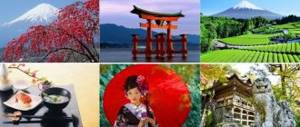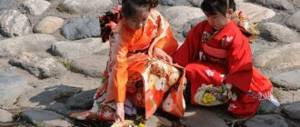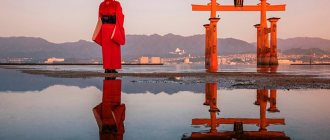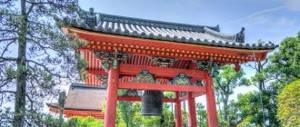Shintoism
Shintoism, unlike other major religions, has no founder and no scriptures or texts. On a collective level, Shinto is a term for all faiths, but on a personal level, Shinto implies a belief in a deity (kami), incorporating the spiritual mind of the kami through worship and fellowship. Shintoism arose with the advent of Japanese civilization and gradually developed over the centuries to the present day. The word Shinto first appears in the Nihonshoki (Chronicles of Japan) in the early 8th century with the intention of distinguishing this indigenous faith from the more recently emerging religions of Buddhism, Confucianism and Taoism. The word Shinto ("Way of the Gods") was borrowed from written Chinese (shén dào), combining two Chinese characters: "shin", which means "kami i.e. deity "; and "tō" or "miti te path" means a philosophical path or study.
A Japanese man is arrested for stealing 30 yen (RUR 18) from a Shinto shrine.
Sects
Already in the middle of the 19th century, a gradual crisis of traditional religions began in Japan. Shinto and Buddhism are no longer meeting the pressing religious needs of many (especially young) Japanese. Therefore, various “new sects” of varying degrees of radicalism began to appear on the scene. They are characterized by the unconditional cult of Teachers - leaders of sects, simplification of worship and doctrine, the willingness of believers to give everything they have (including life) for the good of the sect, fanaticism, intolerance towards other religions, and belief in the imminent End of the World.
The most famous such sect now is Aum Shinrikyo, founded by Asahara Shoko. However, sects usually do not engage in terrorism and do not particularly interfere with the lives of those who are not members of them.
Kami concept
To understand the concept of kami, it is important to erase the prejudice caused by the word god, limited by the translation that is often used for the word kami. Shintoism does not believe in the concept of an absolute god who is the creator of both humans and nature. It would be best to quote the opinion of Norinaga Motoori, a late 18th century scholar who wrote: “Anything that seemed strikingly impressive, possessed qualities of perfection and virtue, and inspired a sense of awe, was called kami.” Here, the “quality of perfection” refers to a tremendous power that has a great influence on many things. It is beyond human strength or human capabilities and brings a person good luck and happiness, but at the same time it can bring misfortune or evil.
Prerequisites for the occurrence
On the territory of the Japanese islands, in addition to the local population, emigrants from mainland China, the Far East, and Korea live. In their “new homeland,” the settlers encountered not only wonderful nature and fertile soil, but also the trembling surface of the earth, as well as huge waves that appeared for no apparent reason. They were disturbed by the constant rustling and stirring produced by large subtropical insects in the bushes and treetops. Therefore, people came up with an explanation for natural processes, endowing surrounding objects and phenomena with their own consciousness - the spirits of kami.
The word “Shinto” first appears in the Nihongi, a canonical text, when mentioning Emperor Yomei.
Shintoism is based on the understanding that the world around us (including man himself) belongs to the kami. The term "Shinto" can literally be translated as "way of the gods."
This religion is fundamentally different from European beliefs. A person is not a construct specially created by a higher mind, but a natural part of the real world. The worship of magical objects represents the “appeasement” of angry, powerful spiritual entities.
Japanese beliefs
The ancient Japanese never separated spiritual and material existence, but believed that both were inseparable, viewing everything in a spiritual sense. In other words, they did not draw a line between a particular object and the work of that object. According to Shinto cosmology, the world is created with the appearance of a single kami, representing the universe, and then the kami of birth and growth appear. From the sky, a male Kami and a female Kami appear who give birth to various deities, the land of Japan and its nature, as well as its people. The belief of Shintoism begins with the belief in this mythology. Thus, Shintoism does not recognize the difference or cessation of use of kami, nature or people.
Buddhism and Shintoism
Buddhism appeared in Japan in the 6th century and soon began to penetrate the life of the Japanese. Since there was no conflict between Buddhism and Shintoism, they merged with each other to form a unique fusion. Even in the Imperial Palace, the Emperor of Japan (Tenno) revered and worshiped Buddha as well as the Shinto kami. This fusion of kami and Buddha is called "Shin-Butsu-Shugou", and this state lasted until the end of the 19th century. This is the main reason why many Japanese do not make a clear distinction between Buddhist temples and Shinto shrines, or between Buddha and kami. In other words, they are both respected entities that are worshiped by the Japanese. Counting the number of official followers of Shintoism in Japan is not an easy task. According to statistics, he currently has 119 million official subscribers. In Japan, it is customary that the events of “life” are dealt with by Shintoism, and the events of “death” or “afterlife” are dealt with by Buddhism. In this sense, it is believed that most Japanese who take part in Shinto rituals also take part in Buddhist ancestor worship.
Things to Remember When Visiting Temples in Japan
Shintoism and the Imperial Family
In Shintoism, the Emperor of Japan (Tenno) is considered a descendant of Amaterasu-Ōmikami (the Sun Goddess), who is enshrined in the Ise Grand Shrine. Since the founding of the nation, Tenno himself has performed Shinto rituals at the Imperial Palace to pray to the deities centered on Amaterasu-Ōmikami for the happiness of the people, for the long existence of the nation, and for world peace. In the shrines of the Imperial Palace, there are clerics and women who help the Tenno perform rituals. Tenno perform these rites about 40 times a year. This may be why some scholars call Tenno the “high priest” of Shintoism.
Shinto shrines
There are many Shinto shrines throughout Japan. Jinja (神社) is a Shinto shrine, along with the area around it. More often, “jinja” refers only to the sanctuary itself. Each shrine has been revered by the people of the area since its founding and has maintained close contact with the local community through religious events and festivals.
Deeply indebted to nature, the Japanese people recognized its spiritual powers that brought life, fertility and prosperity. Divine spirits dwell throughout nature and bring joy and generosity into our lives. Mountains, deep valleys and the vast ocean are seen as the abode of the divine. Other natural objects, such as majestic trees and special rocks, are also considered symbols of divine spirits. Because of this close contact with nature and the divine, the Japanese people continue to respect and be inspired by its spiritual beauty. At the same time, the Japanese have long revered their ancestors, who made enormous contributions to the good of society.
The main attractions of Kyoto. Top 5
In ancient times, rituals were performed mainly in the open air. Mysterious, unusual and stunningly beautiful places were considered the habitat of the kami. House buildings as a place for holding rituals were quite rare. It was assumed that the kami was not constantly in the place of prayer, but could go there if he considered it necessary to listen to the requests of people. Since kami are incorporeal, in order to contact people they need an object that will become their physical embodiment. Such items are called shintai. Initially, such noticeable objects as old sakaki trees and iwakura rocks served as shintai.
Ancestor cult in Japan
The spirit is believed to be immortal. When he passes from one form to another, he becomes “contaminated” and becomes angry and confused. After all, people, for the most part, are not to blame for death, the cause of displacement.
Accordingly, in order to soften the anger of the deceased, the living show love and attention, leave offerings (rice and sake) and perform certain rituals. It is believed that after death, a kami undergoes purification in the valley of yellow springs, and only after thirty-three years does it restore the lost harmony. Then he meets the spirits of friends whom he knew during life, who also managed to die and change their spiritual form.
The fear of contamination from the dead is so high among the Japanese that they move from the place where someone died. The Japanese even moved the capital of the state after the death of the next emperor.
Rituals
Over time, specific boundaries began to appear at the place where the kami converged. These boundaries can be marked by trees planted along the perimeter, called himorogi. Borders can also be lined with stones or fenced with rope. In this case they are called iwasaka. Both words can also be synonymous with the sanctuary itself. Along with the borders, passages appeared in them, marked with the help of torii. Later, mihasir pillars dug into the ground also began to be used as shintai.
Torii
However, when Buddhism appeared in Japan, people began to worship images of Buddha placed in buildings. It is believed that Shinto, influenced by this style, began to embody the spirit of the kami in the building, and over time this became a popular custom.
The strengthening of imperial power and the expansion of the influence of the Amaterasu cult led to the fact that mirrors became popular in shintai. The mirror was hung in front of the room with the body of the god, as an external symbol of holiness. Since the end of the 19th century, it has already become the same symbol of Shintoism as the cross for Christianity. Other two symbols of the imperial family - the sword and jasper beads - also gained popularity.
At various turning points in life, Japanese people often make visits to shrines to pray for divine protection and to thank the deities for their help. These rites of passage for the Japanese begin with the hatsumiya rite. This is a ceremony to celebrate the first visit of a newborn child to the temple, who must be recognized as a new member of the community by the local deity. Next comes a festival called Shichi-go-san. Boys aged five and girls in their third and seventh year visit the shrine to report their healthy development and receive divine blessings.
Special rites of purification and blessing are also required when a young person reaches his maturity. However, the highlight of life is the marriage ceremony, when the bride and groom exchange ritual cups of sake in front of the deity and take the oath of husband and wife. Purification rituals and prayers are performed on many other occasions. By repeating such life cycle rituals, the Japanese seek a way of life full of peace and joy in communion with the divine.
Views: 2,449
Share link:
- Tweet
- Share posts on Tumblr
- Telegram
- More
- by email
- Seal
Christianity
Christianity came to Japan in the middle of the 16th century, along with the Catholic missionaries of Francisco Javier. The famous Japanese military leader and prince Oda Nobunaga supported Christians and himself accepted this faith, as he found in them material support (supplies of firearms) to fight his enemies.
After the Tokugawa clan came to power, they began to fight Christians mercilessly. Christianity was banned until the Meiji Restoration in 1867, when freedom of conscience was declared.
Currently, about one percent of the Japanese population consider themselves Christians. However, such an attribute of Christianity as “wedding” is now becoming more and more popular, since it turns out to be much cheaper than a wedding according to the traditional rite. Many of those participating in Christian rituals are attracted not by the religious, but by the aesthetic side of worship. Therefore, Orthodoxy is unexpectedly very popular in Japan.











